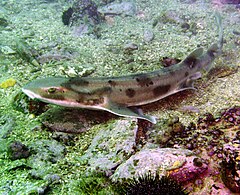Draughtsboard shark
| Draughtsboard shark | |
|---|---|
 |
|
| Scientific classification | |
| Kingdom: | Animalia |
| Phylum: | Chordata |
| Class: | Chondrichthyes |
| Subclass: | Elasmobranchii |
| Superorder: | Selachimorpha |
| Order: | Carcharhiniformes |
| Family: | Scyliorhinidae |
| Genus: | Cephaloscyllium |
| Species: | C. isabellum |
| Binomial name | |
|
Cephaloscyllium isabellum (Bonnaterre, 1788) |
|
 |
|
| Range of the draughtsboard shark | |
| Synonyms | |
|
Scyllium lima Richardson, 1843 |
|
Scyllium lima Richardson, 1843
Squalus isabella Bonnaterre, 1788
Squalus isabella Gmelin, 1789
The draughtsboard shark (Cephaloscyllium isabellum) is a species of catshark, and part of the family Scyliorhinidae, so named for its "checkerboard" color pattern of dark blotches. It is endemic to New Zealand, where it is also known as the carpet shark (which usually refers to the entire order Orectolobiformes). This shark typically reaches 1 m (3.3 ft) in length and has a thick body with a broad, flattened head and a capacious mouth. Its two dorsal fins are placed far back on the body, with the first much larger than the second.
Occurring down to a depth of 673 m (2,208 ft), the draughtsboard shark frequents rocky reefs during the day and sandy flats at night. Its diet consists of fishes and invertebrates. When threatened by a predator, it can take water or air into its body to inflate its body, which may be the cause of its unusual habit of barking like a dog. This species is oviparous, with females laying smooth, tendril-bearing egg capsules in pairs. Draughtsboard sharks are often taken as bycatch by commercial fisheries, but are probably hardy enough to survive the experience. The International Union for Conservation of Nature (IUCN) has listed this species under Least Concern.
...
Wikipedia

